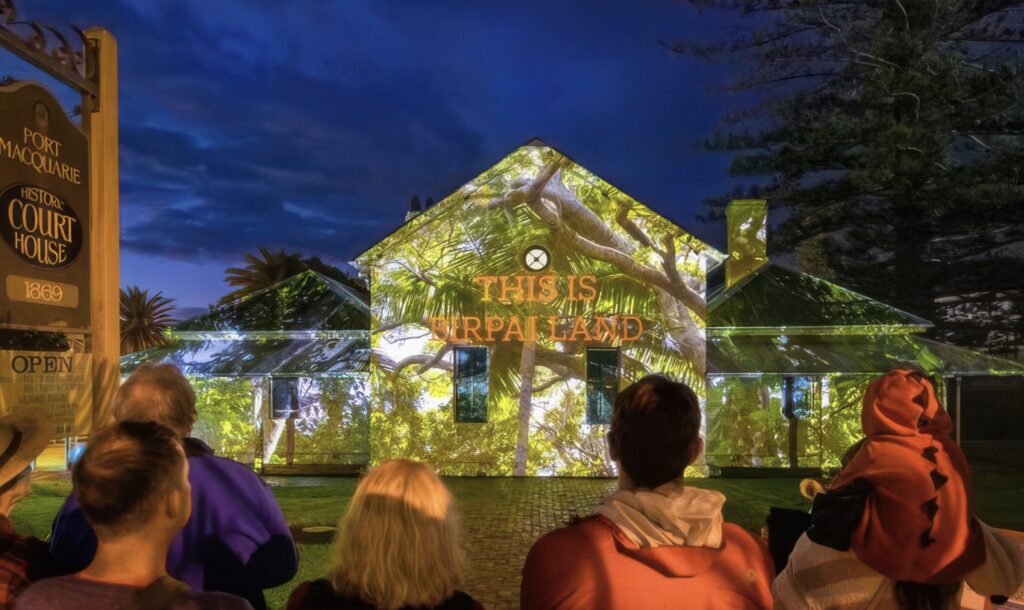
This semester I worked with Studio ESEM https://www.studioesem.com/ to organise the digital sources from one of their past projects in an archive and present it in a new non-linear digital format.
The project is based on Studio ESEM’s 2021 video projection installation Wakulda (Weaving our Stories As One), https://www.studioesem.com/projects/wakulda which marked the 200th anniversary of the British settlement of Port Macquarie, by reflecting on Indigenous/Birpai perspectives on this history.
The digital interpretation element of my project presents the sources that Studio ESEM collected during the production of Wakulda in a new non-linear digital format. My creative approach and presentation of the sources will enable the audience to engage with these stories in a new way. In the new format I was able to further explore and develop narrative threads from the original project such as Indigenous/Birpai perspectives on and connection to their Country, the history and impact of conservation movements in the Port Macquarie-Hastings area
My project, like the original Wakulda project focuses on the perspectives of the First Nations community of Port Macquarie, particularly the local Birpai people. The original project was significant in focusing on First Nations perspectives on a colonial anniversary, and making their voices heard in the (literal) center of the town in Port Macquarie, projected for the whole community on the Old Courthouse Building. The centering of these perspectives and personal experiences which have historically been excluded from public histories implicitly makes the argument that these are perspectives that must be listened to to gain a proper understanding of Australia’s past and to address the present day inequalities that are the effects of colonization in Australia. The project also highlights the significance of historic conservation movements in Port Macquarie and the women who lead them, a history which the original Wakulda project shone a light on, but which had historically not been well known to the Port Macquarie community, and my project also argues that this is an important history to recognize.


I worked with the sources that Studio ESEM collected during the production of Wakulda, which were all in digital form on a drive. This included images of historical documents and artworks; audio recordings of personal oral histories; interviews with local historians; location video and photography of Port Macquarie and the natural environment around it; photos of individuals who were interviewed; photos and videos of local community activities such as a weaving workshop and choir performance; and historical photographs. I focused particularly on the oral histories and interviews, as these were not fully captured in the original video projection, and they reveal important perspectives and insights about Port Macquarie’s history. In the digital presentation, I supplemented these with images and video to contextualise them.
In the process of cataloguing the sources, I gained a thorough understanding of this archive and found particular themes in common throughout the sources. The three key themes of my project are embodied by the sections of my digital presentation. The first was Birpai Country: Weaving Community, which focused on the local Indigenous community, members of the Birpai nations and other nations and their connection to Country. It explored the meaning of the place to them, on one hand the physical space and natural environment, and on the other, the community and people. The second theme was Conservation in Port Macquarie: A Vital Legacy, where I focused on the contributions of local woman Grace Easterbrook to protecting the natural environment and the legacy of the Port Macquarie Conservation Society. Finally, Injustices, the past, and making a better future, focused on the injustices of colonization, the historical and current day impacts on Indigenous Australians, and the efforts members of the Port Macquarie Indigenous community to create a better world for future generations.
This project will give a platform for the voices of the local Indigenous community of Port Macquarie, highlighting their perspectives. These perspectives need to be amplified and listened to for both historians and the general public to gain a proper understanding of Australia’s past: as many of the interview participants mention, truth-telling is key aspect of achieving progress. Hopefully this project will make this history more accessible to the general public through an engaging digital format, not only for the residents of Port Macquarie, but anyone who wants to gain a better understanding of Indigenous Australian history and experiences.
In the production of the original Wakulda project, Studio ESEM were focused on producing the final product and had not organized the sources they had collected. The sources still had much value to explore, as much of the sources collected had not been included in the video projection, given the 10 minute runtime. The video is still being projected in Port Macquarie, but will end projection next year, so Studio ESEM is looking to long term and continuing projects in Port Macquarie: they have continued to collaborate with Aunty Rhonda Radley, who was significantly involved in Wakulda, on various other projects.
Firstly, my spreadsheet organizes the sources into a usable archive that can be used to make the use of them in any future projects easier and ultimately help make these sources accessible to the public
Secondly my “scrollytelling” presentation of the sources, explores a new way of presenting the sources, further develops narratives from the original Wakulda project and provides a basis for Studio ESEM to explore this new format, which they are keen on building on.
The documentation of sources in the spreadsheet did not require much creativity as it followed a model that Studio ESEM had used previously. For the “scrollytelling” page Studio ESEM wanted me to explore ways of presenting the sources digitally, but there was plenty of scope for what kind of digital presentation, techniques and the themes that I drew out of the sources. I used the format of a “scrollytelling” website, which allowed me to explore the full depth of the audio and visual digital sources I was working with. The connection of the audience with the individuals who were featured was made much more concrete by including audio clips of their responses, along with transcriptions The scrollytelling pages will eventually be published on a website, and made accessible to the general public. All the audio sources are also provided in text form, which helps accessibility. Through this project, Studio ESEM wanted me to explore digital presentation of stories and histories of the Indigenous Australian community of Port Macquarie, and what this format could offer. This is part of a larger project they are working on to platform these narratives and perspectives in a digital format. They want to further develop the work I did with me (which I am keen to do) and incorporate it as part of this larger project

